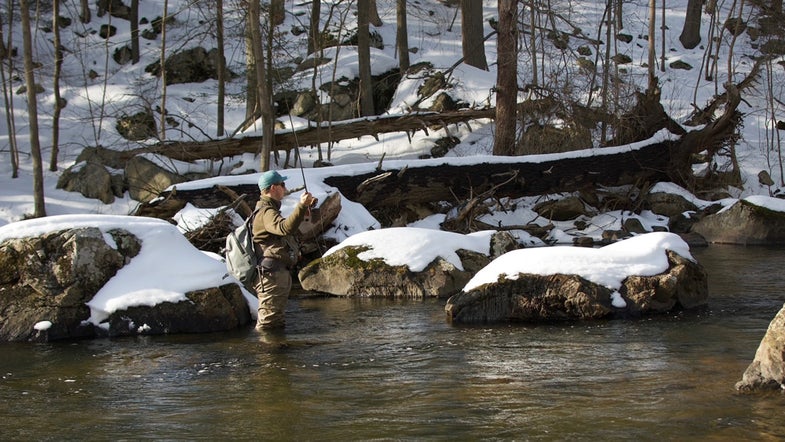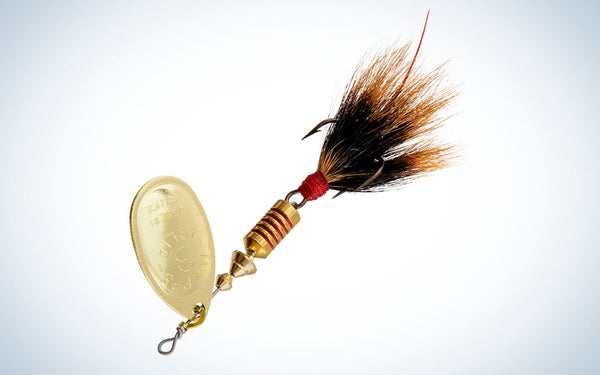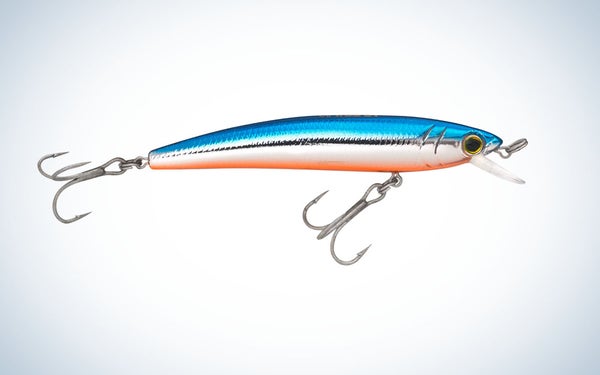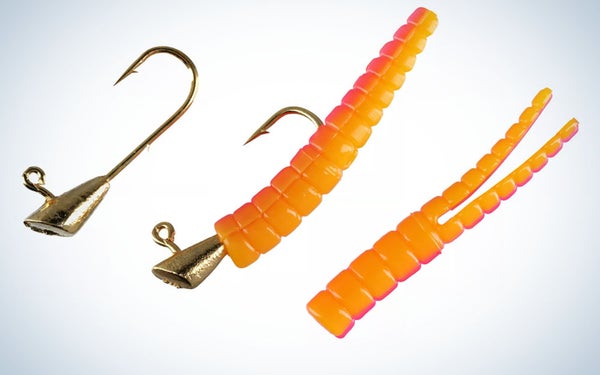Winter Trout Fishing: Tips, Tactics, and Techniques to Land More Fish
Don’t hang up the ultra-light rod just yet. Extend your season by leaning on these simple winter trout fishing tips

Winter trout fishing is a funny thing. Some people love it because the crowds are gone, and they can bank on having long stretches of great water all to themselves. Other people hang up the trout gear in fall, often because they believe catching them in the middle of winter is just too much effort. They’re not entirely wrong: Winter trout make you work a little harder. But many anglers believe the biggest challenge is simply getting them to eat. It’s not. The biggest challenge is knowing exactly when to go winter trout fishing and when to stay home. Time it right, and you can score as many fish now as you would in spring. Here are some simple winter trout fishing tips for picking the right day, finding the fish, and fooling them. Because the key to forgetting about your numb toes is keeping your rod bent.

Best Water Conditions for Winter Trout Fishing
The flow and conditions of your favorite trout stream will dictate your success in the dead of winter more than anything else. Before ever worrying about what trout lure or bait you’re going to cast, you need to monitor water levels and pay close attention to the weather. This is extra critical if you are primarily fishing free stone streams and rivers like I am, because these waters are the most easily influenced by air temperature and runoff.
Long spans of bitter-cold temperatures and sunny skies often equal miserable winter trout fishing. You may not be able to fish at all if the edges ice over too badly or the stream is slushed up, but even if ice isn’t a factor, you can expect the water to be ultra-clear, low, and probably just a few notches above freezing depending on where you live. In these conditions, trout hunker down, both to minimize the energy they expend and because they can be more easily seen by birds of prey. Scoring a bite—which will often be so light you barely feel it—can be more of an endurance test than a fun outing, so I avoid these conditions all together.
What I wait for is rain or a few back-to-back days of elevated temperatures that might melt just enough snow and ice to bump the flows on my local streams. I want the water to be stained, but not chocolate milk. This has led me to spend many days soaked to the skin in winter rainstorms, but those days are also some of the most productive. Given that trout feeding slows in frigid, clear water, a bump in flow and a good stain is like a hall pass for them, because they’re not as exposed, stained water usually jumps up a few degrees in temperature, and they know those conditions will be fleeting, so they’ll fill up while they have the opportunity.
Where to Fish for Winter Trout
One of the hardest things to peg is exactly where you’ll find trout in winter. The reality is their location can vary just as much now as it will any other time of year. And—just like any other time of year—water conditions will dictate the sweet spots.
The lower, clearer, and colder the water, the more you can bank on the fish seeking refuge in deeper holes with slow current or very little current at all. Holding in these areas allows them to expend minimal energy versus holding in fast water, and the depth provides safety from aerial attack. Deep, slow holes are always worth fishing in winter, but keep in mind that these spots tend to be highly pressured by anglers and the minimized flow gives trout plenty of time to study your offering. In other words, there might be 20 trout in front of you, but don’t always expect them to be ravenous.
Conversely, a simple change like a slight bump in flow, dirtying of the water, or upward nudge in water temperature of a degree or two can be all it takes to get fish out of the depths and into areas where they’re a bit more aggressive and less discerning. I’ve had great success under good conditions in areas of medium depth—say, 3 to 5 feet—and medium flow. The more diversity your stream has, the better. And wherever you catch your first trout, stay there or focus on similar spots, because you can assume more trout are favoring those areas that day. And for the record, it’s not that trout never hold in shallow riffle water in winter, it’s just that overall, depth and slower flows tend to hold more fish.

Best Baits for Winter Trout
Regardless of water levels and how prime the conditions are, it’s still winter and the water is much colder than it is during the rest of the season. With that in mind, assume the fish may not be as aggressive or willing to move as far and as fast as they might during warmer times. Understanding that makes lure selection much easier.
In-line spinners like a Mepps or Panther Martin might be your go-tos in the spring or fall, but success with these lures hinges on the willingness of trout to chase a meal. Spinners need to be moving forward for the blades to spin. There’s really no way to finesse a spinner, meaning pausing or letting it fall or imparting very subtle action without moving it very far. If you’re a spinner fan, embrace small floating or suspending jerkbaits in winter.
One of my all-time favorites is the Yo-Zuri Pin’s Minnow in the 2 ¾-inch size. It casts as far and accurately as a spinner when fished on a light rod, and I can twitch it gently to make it flash and pivot without moving it out of the zone too fast. A trout may only be willing to give a short burst of energy to feed in winter, so the less it has to work for a meal, the more likely it is to use that burst to smack your lure.
It is, of course, common in winter that trout just aren’t interested in larger meals that jerkbaits represent, which is why I never hit a winter trout stream without my trusty Trout Magnets. These tiny, soft-plastic mealworm imitations are simple in design but incredibly potent. Kits come with micro jigheads that have a slanted face which deflects water. As these lures drift gently downstream, that deflection makes them quiver, shimmy, and flash ever so slightly. They present a slow-moving, natural target that even the chilliest trout rarely resist. I like to hang mine under a small slip float so I can quickly adjust the depth, and while there are dozens of colors available, you won’t find me on a trout stream in winter without gold and pink.

Four Winter Fly Fishing Tips for Trout
Winter can be the most rewarding season of the year for fly anglers. If you can stand the cold, you just might have the river to yourself, experiencing solitude that’s rarely found when the mayflies are hatching in spring and summer. But there’s another reason to get out and fish between December and March: Winter can also be the most technically challenging season, demanding precision and skill more than any other time of the year. If you can catch fish now, you can catch them any time. The trick to catching fish with flies in the winter boils down to four simple rules:
- Slow Down
- Size Down
- Tone Down
- Present Down(stream)
1. Slow Down
The Trout Forecast
When water temperatures drop, the trout themselves slow down. Their metabolisms decrease. They become more lethargic. They don’t chase flies as actively as they would when the water temperatures are in the ideal trout zone of 45 to 65 degrees. One way around that, of course, is to fish in tailwaters—rivers that flow from bottom-release dams. The water released from those dams remains at a relatively constant temperature (usually in the 40s or 50s) throughout the whole year. So the fish don’t feel much difference between July and January—though shorter days and seasonally different insect hatches do indeed change the angling paradigms substantially between summer and winter.
Stalk Softly and Cast High
When trout are in the slowed down winter mode, the angler should slow down as well. Rivers are usually at their lowest and clearest in midwinter. Bright-white, snow-covered banks reflect light and exaggerate shadows more. While winter trout typically aren’t as “jumpy” as they are in the summer, that doesn’t mean they are much less spooky. I typically try to slow my pace and movements by at least 25 percent when I fish in the winter. I am particularly concerned about the position of the lower winter sun, so I can be careful not to cast long shadows over the runs I target. I also spend more time high on the riverbanks spotting fish before I cast. If you can see and then specifically target trout, your odds of hooking up are exponentially greater than they are when blind casting in the winter.
Make Slow, Short Strips
Streamer fishing can be good in winter, especially in tailwaters. But again, I tend to slow the tempo down a tad in winter. Instead of the long, aggressive strips I make with my fly line in summer in fall, I’m more apt to make slow, choppy strips in winter.

2. Size Down
Be a Nymphing Maniac
I typically fish with smaller flies in the winter, and 99 percent of winter fly fishing is nymph fishing. At any time of the year, midges comprise more than 50 percent of a trout’s diet. So these small insects are extremely important for anglers to understand and imitate in every season. But the midge game is especially important in winter, because there is not much mayfly or terrestrial activity then.
Black Stoneflies Are Best
Another very important bug to key into during the winter is the little black stonefly. While these stoneflies share the same basic shapes and dark colors as their spring and summer counterparts, these insects are typically much smaller (like size 16 or smaller). While egg flies (small ones) and, in some cases, attractors like Prince Nymphs are useful winter patterns, an angler cannot go wrong in most locales if they fish little black stoneflies and small midge patterns (like zebra midges, juju midges, and black beauties) the vast majority of the time.
Lighten Your Tippet
I also make a point to size down on my fly rig when I trout fish in the winter. If I normally fish a river with 4X tippet, I’ll usually drop down to 5X. I think the light and shadow contrast on bright winter days added to the low clear water is a recipe for making trout more leader shy than they might normally be in summer. It’s also important to drift flies directly to the trout in winter, so smaller tippet helps with presentation.
Same With Your Strike Indicator
I never throw big, gaudy strike indicators in the winter. Instead, I prefer to use small pieces of yarn, pinch-on foam, or when the water is really low and slow, I’ll use a dry fly like as small parachute Adams as my de-facto strike indicator.
3. Tone Down
Be Dull (Seriously)
As a rule of thumb, winter demands duller, darker colors more than any other season. That applies to everything—from the flies you fish, to the colors you wear on your body. Typically, small black flies are best in winter. Tans, browns, and greens also tend to work well. I try to steer away from the bright accents like sparkly wing cases and shiny beads as much as possible. Black or glass beads tend to work better for me when I want to use a weighted fly. And while I am not afraid to fish in a loud Hawaiian shirt in the spring and summer, in winter I typically wear white, black, tan, or sky blue. On a snowy riverbank, a red baseball cap is going to be a dead giveaway to the trout, and it will negatively impact your fishing.
Wait Longer Between Casts
Another important factor of the Tone Down rule has to do with your casting tempo. You cannot be flogging the water in winter. Wait at least 25 percent longer between casts, and take time to watch fish react to those casts, even if they don’t eat the fly. A trout’s body language will tell you when to cast more clearly in the winter than in any other season.
4. Present Down(stream)
Cast Down
While most of us like to fish from downstream to upstream, in winter I make 90 percent of my presentations—even nymph presentations—in a downstream direction. I think the prospect of “lining” the trout is a far greater risk in winter than in any other season. When I see a trout holding in a run, I first factor where the sun is relative to my position, and get myself in a spot where I can see the fish (without staring into surface glare) without creating shadows. Drop the flies several feet upstream of the target fish and let them drift into the zone. Strikes can be exceptionally subtle in winter, so set the hook (gently) on even the slightest stall, stagger, or hiccup in your indicator or line.
Watch Your Weight
Another important thing to remember when fly fishing for trout in winter is those lethargic fish are going to move less to eat a fly. To force them to eat, you have to hit them in the head. Do that, and they will eat flies. The number-one factor in making a good presentation is weight. Change your weight at least five times before you even think about changing your fly pattern. You want the bugs suspended so they drift exactly into the feeding lane. That may require tinkering with your weight from run to run. It also usually means making many casts to earn a bite. So be patient, and pause between repeat casts.


